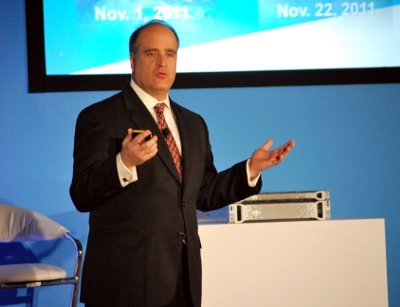HP’s announcement of “servers that manage themselves” earlier this week in Las Vegas included a number of data center infrastructure management (DCIM) features. Integrated into the new eighth-generation (Gen8) ProLiant servers, the features add to the machines’ self-sufficiency.
Besides performance improvements (which HP says are stellar) smart servers that take care of themselves was the main message in the Gen8 announcement. To put it in numbers, the vendor is saying the new architecture that resulted from the two-year R&D project called Voyager can give 30 hours of admin time a year back to the business, freeing up the admins to innovate.
ProLiant’s DCIM features are part of the puzzle, but the ones announced along with the first line of Gen8 machines seem to mostly be limited to Gen8 machines and other HP equipment that supports them.
To be sure, the company has had DCIM solutions for heterogeneous environments, but has not so far extended this heterogeneity to the ProActive Insight architecture at the heart of the latest-generation ProLiant blades and servers.
The DCIM features included in the announcement were automatic identification of server location, power monitoring and temperature monitoring. Only one of these is new to HP’s portfolio and that is the servers’ awareness of their location in the data center and within the rack.
The feature is called Location Discovery Services. Used in concert with power and temperature monitoring features, it can be used effectively to pinpoint most appropriate locations for new equipment on the data center floor. This can save tons of time compared to looking for the best spot manually.
One caveat (a rather big one) with the Location Discovery Services is the feature can only be used when the servers are installed in one of HP’s new IT racks, according to what HP execs said during a press conference in Las Vegas this week. This makes it less valuable to data centers with a variety of racks installed, since they would have to use other tools for asset tracking in areas populated with racks other than HP’s new ones.
While power tracking has been in HP’s portfolio and available to ProLiant customers for several years. The company’s server management platform Insight Control included tools for power management, monitoring and power capping.
HP took power management further with its line of intelligent power distribution units (iPDUs) it launched in 2010.
According to Mark Potter, SVP and GM for industry standard servers and software at HP, Power Discovery Services that were part of the Gen8 announcement included a new feature for iPDUs which made whatever is connected to them more resilient.
It prevents fallout from the common mistake of connecting redundant server power connections to a single circuit, Potter said. This issue is prevented by both the new iPDUs and power supplies in the new ProLiant machines.
Again, the new power-management features are only available to those that also buy (or already have) HP’s iPDUs.
The new servers come with HP’s previously existing thermal-monitoring solution 3D Sea of Sensors. The “sea” consists of 32 sensors that measure temperature and dynamically adjust server components, such as cooling fans, memory and I/O processing to optimize cooling resources for efficiency.

